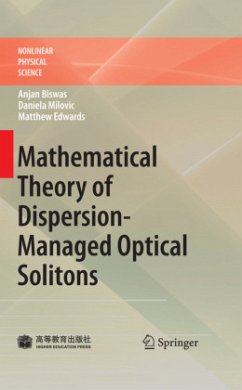"Mathematical Theory of Dispersion-Managed Optical Solitons" discusses recent advances covering optical solitons, soliton perturbation, optical cross-talk, Gabitov-Turitsyn Equations, quasi-linear pulses, and higher order Gabitov-Turitsyn Equations. Focusing on a mathematical perspective, the book bridges the gap between concepts in engineering and mathematics, and gives an outlook to many new topics for further research.
The book is intended for researchers and graduate students in applied mathematics, physics and engineering and also it will be of interest to those who are conducting research in nonlinear fiber optics.
Dr. Anjan Biswas is an Associate Professor at the Department of Applied Mathematics & Theoretical Physics, Delaware State University, Dover, DE, USA; Dr. Daniela Milovic is an Associate Professor at the Department of Telecommunications, Faculty of Electronic Engineering, University of Nis, Serbia; Dr. Matthew Edwards is the Dean of the School ofArts and Sciences at Alabama A & M University in Huntsville, AL, USA.
The book is intended for researchers and graduate students in applied mathematics, physics and engineering and also it will be of interest to those who are conducting research in nonlinear fiber optics.
Dr. Anjan Biswas is an Associate Professor at the Department of Applied Mathematics & Theoretical Physics, Delaware State University, Dover, DE, USA; Dr. Daniela Milovic is an Associate Professor at the Department of Telecommunications, Faculty of Electronic Engineering, University of Nis, Serbia; Dr. Matthew Edwards is the Dean of the School ofArts and Sciences at Alabama A & M University in Huntsville, AL, USA.
From the reviews:
"The book is devoted to a detailed exposition of the concept of dispersion-managed optical solitons suggested for high-rate data transmission in fiber optical communication systems. ... The book presents all calculations in great detail and it can be useful for experts and graduate students in applied mathematics, applied physics and engineering interested in optical communication systems." (Anatoly M. Kamchatnov, Mathematical Reviews, Issue 2012 k)
"The book is devoted to a detailed exposition of the concept of dispersion-managed optical solitons suggested for high-rate data transmission in fiber optical communication systems. ... The book presents all calculations in great detail and it can be useful for experts and graduate students in applied mathematics, applied physics and engineering interested in optical communication systems." (Anatoly M. Kamchatnov, Mathematical Reviews, Issue 2012 k)








